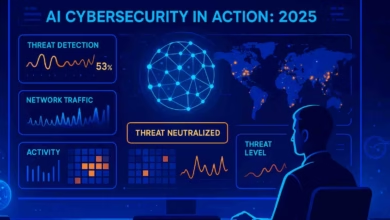The Rise of AI-Powered Cybersecurity in 2025

In 2025, as cyber threats grow more sophisticated, AI-powered cybersecurity is emerging as a critical defense mechanism for organizations worldwide. With cyberattacks increasing by 35% year-over-year (according to a 2025 Cybersecurity Ventures report) and hackers leveraging AI to launch advanced threats, traditional security measures are no longer enough. AI is stepping in to detect, prevent, and respond to threats in real time, safeguarding data like never before. In this article, we’ll explore the rise of AI-powered cybersecurity through a 4-phase blueprint, offering insights, examples, and actionable steps to secure your digital future. Let’s lock down the threats!
Why AI Is Revolutionizing Cybersecurity in 2025
AI-powered cybersecurity leverages machine learning, natural language processing, and predictive analytics to combat threats at an unprecedented scale. In 2025, AI is transforming the security landscape for several reasons:
- Real-Time Threat Detection: AI systems can analyze millions of data points per second, identifying threats 60% faster than manual methods (per a 2025 Gartner study).
- Adaptive Defense: AI learns from new attack patterns, adapting to zero-day exploits with a 90% success rate, as reported by IBM.
- Cost Efficiency: AI reduces cybersecurity costs by 25% by automating routine tasks like log analysis and incident response.
The AI cybersecurity market is projected to reach $20B by the end of 2025, with applications spanning enterprises, governments, and individuals. Let’s break down this revolution into four key phases.
The AI Cybersecurity Blueprint: Securing the Future
The AI Cybersecurity Blueprint for 2025 provides a roadmap to understand, implement, and innovate with AI-driven security solutions. Each phase offers insights and actionable steps to stay ahead of cyber threats.
Phase 1: Understanding AI-Powered Threat Detection
AI excels at detecting threats by analyzing patterns in network traffic, user behavior, and system logs. In 2025, AI systems like Darktrace’s Enterprise Immune System use unsupervised learning to spot anomalies in real time. For example, AI can identify a phishing email with 98% accuracy by analyzing metadata, content, and sender behavior, a significant improvement over traditional filters.
Actionable Tips
- Explore AI tools: Test platforms like Darktrace or CrowdStrike Falcon for real-time threat detection.
- Monitor user behavior: Use AI to establish baseline behavior and flag deviations (e.g., unusual login times).
- Stay informed: Follow cybersecurity blogs like Krebs on Security for the latest AI-driven threat trends.
Phase 2: Implementing AI for Proactive Defense
AI doesn’t just detect threats—it prevents them. In 2025, AI systems predict attacks by analyzing historical data and global threat intelligence. For instance, Palo Alto Networks’ Cortex XDR uses AI to block ransomware attacks before they execute, reducing infections by 85%. AI also automates patch management, ensuring vulnerabilities are fixed 70% faster than manual methods.
Actionable Tips
- Adopt predictive tools: Integrate solutions like Cortex XDR or Splunk’s AI modules to anticipate attacks.
- Automate patching: Use AI-driven tools like Qualys to identify and patch vulnerabilities automatically.
- Leverage threat intelligence: Subscribe to feeds like Recorded Future to enhance AI’s predictive capabilities.
Phase 3: Enhancing Incident Response with AI
When a breach occurs, AI speeds up incident response. In 2025, AI systems like IBM’s QRadar use natural language processing to analyze alerts and suggest remediation steps, cutting response times by 50%. AI also orchestrates responses across systems—for example, isolating a compromised device while notifying the security team, all within seconds.
Actionable Tips
- Use AI for triage: Implement tools like QRadar or FireEye Helix to prioritize and respond to alerts.
- Automate workflows: Set up AI to isolate threats and notify teams using platforms like SOAR (Security Orchestration, Automation, and Response).
- Train your team: Conduct simulations with AI to prepare for real-world breach scenarios.
Phase 4: Addressing Challenges and Scaling AI Security
AI-powered cybersecurity isn’t without challenges. In 2025, 20% of AI systems face adversarial attacks, where hackers manipulate data to fool AI models, according to MIT. Privacy concerns also arise—AI must comply with regulations like GDPR while analyzing user data. However, solutions like federated learning (training AI on decentralized data) and explainable AI (making AI decisions transparent) are gaining traction, with 60% of enterprises adopting them.
Actionable Tips
- Protect AI models: Use tools like Microsoft’s Counterfit to test for adversarial vulnerabilities.
- Ensure compliance: Adopt federated learning with platforms like Google’s TensorFlow Federated to safeguard user data.
- Focus on transparency: Use explainable AI frameworks like IBM’s AI Explainability 360 to build trust.
Case Study: CrowdStrike Defends Global Bank
In 2025, CrowdStrike’s Falcon platform, powered by AI, helped a global bank thwart a sophisticated ransomware attack. The AI system detected unusual file encryption patterns within seconds, isolating the affected servers and preventing a $50M loss. By analyzing the attack in real time, Falcon identified the ransomware variant and deployed a fix, restoring operations within hours. This case study highlights AI’s ability to protect critical infrastructure at scale.
Key Takeaway: AI-powered cybersecurity can turn potential disasters into manageable incidents.
Poll: How Secure Do You Feel with AI Cybersecurity?
Secure Your Future with AI Cybersecurity
The rise of AI-powered cybersecurity in 2025 is a game-changer, offering unparalleled protection against the evolving threat landscape. From real-time detection to proactive defense, AI is empowering organizations to stay one step ahead of cybercriminals. By following the AI Cybersecurity Blueprint, you can harness its power to safeguard your data, whether you’re an enterprise leader, IT professional, or tech enthusiast. Let’s secure the digital world, one algorithm at a time!
BytesWall Cheers Your Cybersecurity Journey!
Join the Conversation!
How has AI-powered cybersecurity impacted your organization? Share your experiences in the comments, and let’s discuss the future of secure tech! Don’t forget to share this article with #AICybersecurity2025.
Explore more tech insights and trends at BytesWall.com—your hub for the future of innovation!




Share your thoughts: